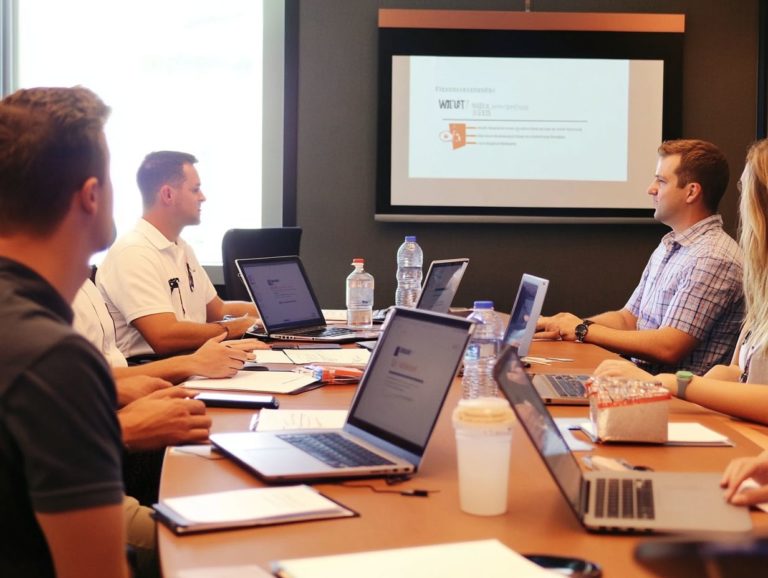the role of social media in cybersecurity threats
Social media has completely transformed the way people connect with others, but it also opens up a new realm of cybersecurity threats.
From phishing scams and identity theft to the rapid spread of harmful content, the risks on these platforms are more prevalent than ever before. This article delves into the various types of cybersecurity threats associated with social media, exploring how these threats propagate and the protective measures you can adopt.
You will examine the role that social media platforms play in tackling these issues, along with the ongoing challenges they encounter. Stay informed and empowered as you navigate this intricate landscape.
Contents
- Key Takeaways:
- The Growing Impact of Social Media in Cybersecurity
- Types of Cybersecurity Threats on Social Media
- How Social Media is Used to Spread Cybersecurity Threats
- Protecting Yourself from Social Media Cybersecurity Threats
- The Role of Social Media Platforms in Combating Threats
- Frequently Asked Questions
- 1. What is the role of social media in cybersecurity threats?
- 2. How does social media facilitate cyber attacks?
- 3. Can social media platforms be used to spread fake news and misinformation related to cybersecurity threats?
- 4. What steps can be taken to protect against cybersecurity threats on social media?
- 5. Are there any best practices for using social media to minimize cybersecurity risks?
- 6. Can companies and organizations also be targeted by cybersecurity threats through social media?
Key Takeaways:

Social media is a hotbed for cyber threats. Protect yourself from phishing and identity theft by practicing safe online habits!
The Growing Impact of Social Media in Cybersecurity
The rapid evolution of social media platforms like LinkedIn, Facebook, Instagram, and Twitter has significantly transformed the landscape of cybersecurity, presenting both new challenges and opportunities for safeguarding sensitive personal information.
As users engage more with these platforms, they often unwittingly expose themselves to a range of security risks and cyber threats. These risks can lead to data breaches, identity theft, and phishing attacks.
The increasing involvement of cybercriminals using tricks to manipulate people makes it even more important for organizations to craft robust social media policies and implement thorough cybersecurity training programs. This proactive approach is essential for protecting their online presence and ensuring secure user engagement.
Types of Cybersecurity Threats on Social Media
Social media platforms have transformed into a fertile ground for a variety of cybersecurity threats. Phishing attacks, malware distribution, and identity theft are just a few of the risks that can jeopardize both individuals and organizations.
The stakes are high, and staying alert is crucial in navigating this digital landscape.
Phishing and Malware Attacks
Phishing and malware attacks are among the most prevalent cybersecurity threats targeting social media. Cybercriminals often entice people through deceptive online quizzes and seemingly innocent links.
These malicious tactics frequently involve impersonating reputable brands or crafting fake profiles, cunningly tricking people into revealing sensitive information, such as passwords or credit card numbers. Statistics reveal that nearly 30% of malware distribution happens via various social media platforms, underscoring the gravity of the situation.
Cybercriminals often use tactics that create urgency or fear, pushing people to act quickly and click on compromised links without a second thought.
How to Protect Yourself
To navigate these risks more effectively, take action now:
- Adjust your privacy settings
- Regularly update your passwords
- Stay vigilant about any suspicious messages
By doing so, you can ensure your online presence remains protected and secure.
Identity Theft and Fraud
Identity theft and fraud have become significant threats in the realm of social media, where cybercriminals skillfully exploit the personal information people share to carry out scams and malicious activities.
These unscrupulous individuals employ various tactics to mine data, including phishing schemes designed to trick people into revealing sensitive information through fake profiles or links. A notable incident involving a popular social media influencer showcased how their account was hijacked after followers were enticed by a fake giveaway, resulting in unauthorized access.
To enhance security, it’s crucial to regularly update passwords, activate two-factor authentication, and exercise caution when sharing personal details in public posts. By staying vigilant and informed, you can significantly bolster your defenses against these pervasive threats.
How Social Media is Used to Spread Cybersecurity Threats

Social media platforms act as a formidable channel for the spread of cybersecurity threats. Fake accounts and impersonations significantly enhance the virality of these malicious activities across networks.
Fake Accounts and Impersonations
Fake accounts and impersonations are rampant on social media, posing significant cybersecurity threats like identity theft and fraud.
Cybercriminals are becoming increasingly cunning. They often craft counterfeit profiles that closely resemble real individuals or established brands.
Techniques such as manipulating people to share personal information and phishing are common. These allow attackers to gather personal information from unsuspecting users to construct convincing identities.
These deceptive accounts can operate undetected for extended periods. This creates a false sense of trust and potentially entices individuals to share sensitive information.
The repercussions for victims can be severe, leading to financial losses and emotional turmoil.
To safeguard against these risks, remain vigilant. Carefully scrutinize account authenticity, and promptly report any suspicious profiles to social media platforms or the relevant authorities.
Virality and Amplification of Threats
The virality of social media significantly amplifies cybersecurity threats. This allows malicious content to spread at lightning speed, heightening the risk of data breaches and security incidents.
In this dynamic landscape, your engagement can unwittingly contribute to the proliferation of harmful links or phishing scams. These often masquerade as legitimate communications.
A post that appears harmless can trigger a cascade of clickbait. Ultimately, this jeopardizes the security of both personal and corporate information.
Take the notorious WannaCry ransomware attack, for instance. It serves as a sobering reminder of how social media was instrumental in the rapid dissemination of warnings and exploits, magnifying its impact on unsuspecting individuals and organizations alike.
This interconnected environment creates a perfect storm for cybercriminals. They skillfully exploit human curiosity and urgency to maximize their reach and effectiveness.
Protecting Yourself from Social Media Cybersecurity Threats
Want to protect yourself from cyber threats? Here’s how! Protecting yourself from cybersecurity threats on social media demands a proactive strategy. This entails establishing a robust social media policy, embracing best practices, and leveraging the tools and resources at your disposal.
Best Practices for Safe Social Media Use
Adhering to best practices for safe social media use can significantly reduce security risks. This helps safeguard your personal information against potential cyber threats.
To achieve this, implement robust password policies. Combine letters, numbers, and symbols, steering clear of easily guessable details like birthdays.
Enabling two-factor authentication adds an extra layer of security. This makes it considerably more challenging for unauthorized users to gain access to your accounts.
Remaining vigilant about sharing personal information is essential. Limit what you disclose publicly and adjust your privacy settings to protect your data.
Regularly auditing your accounts can also be beneficial. Check for any suspicious activity or outdated permissions to provide peace of mind and enhance your overall online safety.
Tools and Resources for Enhanced Security

Utilizing tools and resources specifically crafted for enhanced cybersecurity can significantly bolster your defenses against phishing attacks and other threats that often lurk on social media platforms.
By integrating password managers into your routine, you can create robust, unique passwords for each of your accounts. This effectively minimizes the risk of unauthorized access.
Employing anti-phishing browser extensions provides real-time alerts for suspicious links. This guides you through the digital landscape with greater safety.
Accessing educational materials on identifying potential threats enhances your knowledge. It gives you the power to recognize fraudulent communications before engaging.
Together, these resources not only enhance your protection but also cultivate responsible digital habits. This ensures you remain vigilant while enjoying your social media experiences.
The Role of Social Media Platforms in Combating Threats
Social media platforms play a vital role in fighting cybersecurity threats. They implement robust measures for incident response and provide protection against brand impersonation and phishing attacks.
By leveraging these strategies, you can enhance your security and safeguard your online presence effectively.
Measures Taken by Platforms to Address Threats
Social media platforms have made significant strides in tackling cybersecurity threats. They focus on enhancing engagement and safety through proactive policies and advanced technology.
Using computer systems that utilize artificial intelligence, these platforms can quickly detect and respond to suspicious activities in real-time, ensuring a safer overall experience. For instance, one prominent platform reported a 70% decrease in account takeovers since adopting this technology.
User reporting systems have also been upgraded to enable quicker flagging of inappropriate content and cyber harassment, fostering a community built on accountability.
A notable case study highlighted that after revising its privacy policies and strengthening data protection measures, another platform experienced a remarkable reduction in data breaches.
These proactive strategies not only enhance security but also work to restore your trust, showing the platforms’ commitment to creating a safer digital environment for everyone.
Challenges and Future Solutions
Despite the measures taken by various platforms, significant challenges persist in effectively combating cybersecurity threats on social media. Innovative solutions are essential for enhancing user safety in this ever-evolving landscape.
As cybercriminals continually refine their tactics, they often outpace current defenses, making it difficult for platforms to protect users from sophisticated attacks. Many users may hesitate to adopt necessary security measures due to perceived inconvenience or a lack of awareness about potential risks, creating vulnerabilities that cybercriminals exploit.
Looking ahead, advancements in technology especially in artificial intelligence could be crucial in detecting anomalies and preventing breaches. Additionally, user education campaigns can foster a culture of vigilance, encouraging proactive engagement with security practices.
Act now to make your online experience safer!
Frequently Asked Questions

Social media plays a significant role in cybersecurity threats as it is a common platform for cybercriminals to access personal information, spread malware, and conduct phishing attacks.
Social media allows cybercriminals to gather personal information, such as login credentials and sensitive data, from unsuspecting users. They can also use fake accounts and posts to spread malware and trick users into clicking on malicious links.
Yes, social media is often used to spread fake news and misinformation about cybersecurity threats. This can cause panic and confusion among users, making them more vulnerable to cyber attacks.
Some steps to protect against cybersecurity threats on social media include:
- Using strong and unique passwords.
- Being cautious of suspicious messages and links.
- Regularly updating privacy settings.
Best practices for using social media to minimize cybersecurity risks include:
- Being selective about what information is shared publicly.
- Verifying the legitimacy of links and accounts before clicking.
- Using two-factor authentication for added security.
Yes, companies and organizations are at risk of cybersecurity threats through social media. Cybercriminals can target employees, collect sensitive information, or manipulate individuals to gain access to company systems.
These tactics, known as social engineering, involve tricking people into revealing confidential data. It’s crucial for organizations to be aware of these threats and take proactive measures to protect their information.






